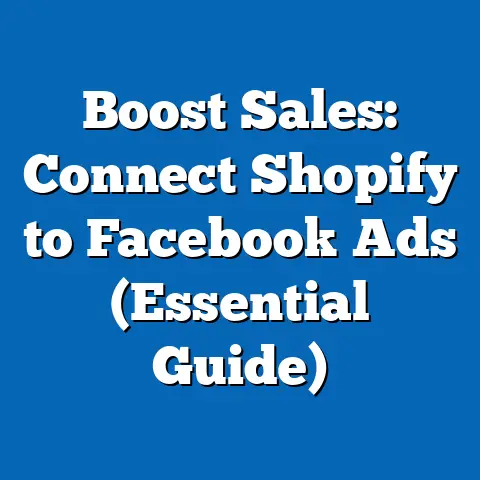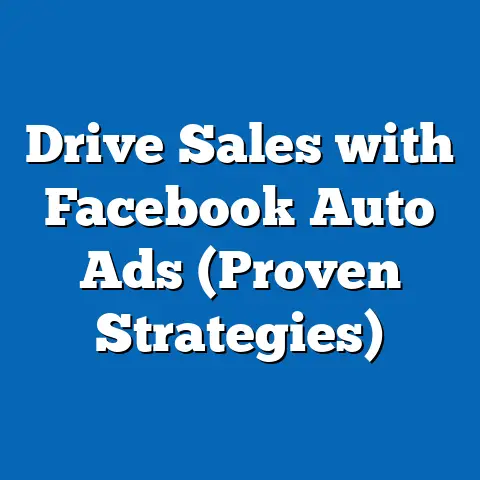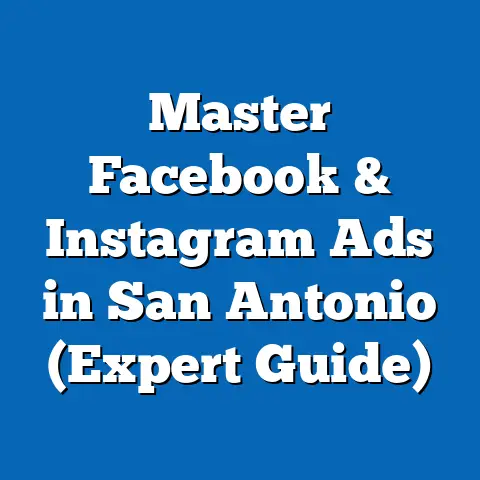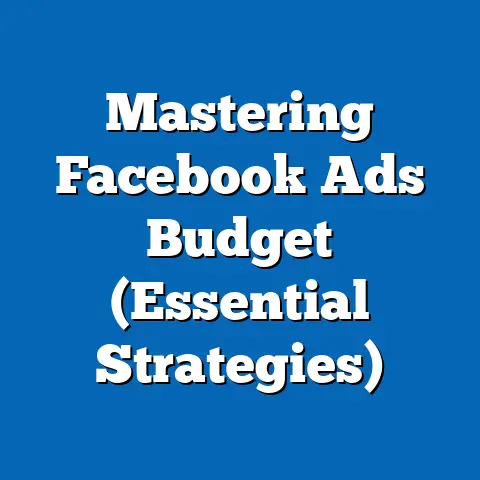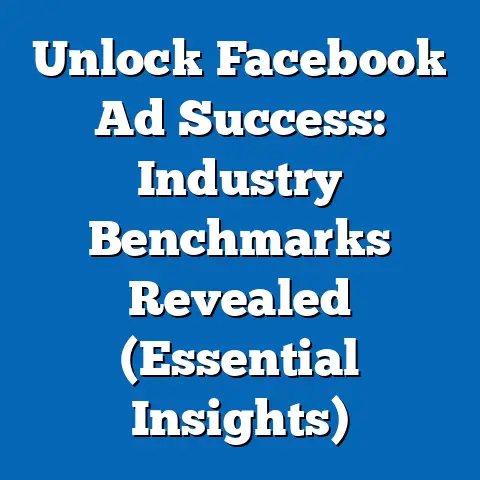Master Facebook Chat Ads (Unlock Expert Support Strategies)
Imagine two scenarios. In one, a potential customer clicks on your Facebook ad and is instantly greeted by a friendly, helpful chatbot that answers their questions, offers personalized recommendations, and guides them seamlessly towards a purchase. This customer feels valued, understood, and ultimately, makes a purchase. In the other scenario, that same customer clicks on your ad and is met with a generic landing page, struggles to find the information they need, and bounces away, never to return.
These two scenarios highlight the power – and the potential pitfalls – of Facebook advertising in today’s digital world. We’ve moved beyond the days of simply blasting out generic ads and hoping for the best. Today, it’s all about personalized, interactive experiences, and that’s where Facebook Chat Ads come in.
I remember when I first started experimenting with Facebook Ads. I was focused on driving traffic to my website, but I wasn’t seeing the conversions I wanted. I was getting clicks, but people weren’t sticking around. It was frustrating to say the least. Then, I discovered Facebook Chat Ads. The ability to have a direct, personalized conversation with potential customers was a game-changer. I started seeing higher engagement rates, better lead generation, and ultimately, more sales.
Facebook Chat Ads represent a paradigm shift in how we approach online advertising. They allow us to move away from one-way communication and embrace a more conversational, customer-centric approach. Instead of simply pushing products or services, we can engage in meaningful dialogues, build relationships, and provide instant support.
This guide is designed to be your comprehensive resource for mastering Facebook Chat Ads. I’m going to take you from the fundamentals to advanced strategies, equipping you with the knowledge and tools you need to create engaging chat experiences that drive real results. We’ll explore everything from setting up your first Chat Ad to crafting compelling chat flows, leveraging automation, and analyzing your results.
By the end of this article, you’ll not only understand what Facebook Chat Ads are and how they work, but you’ll also have a clear roadmap for implementing them effectively in your own marketing strategy. Get ready to unlock the power of personalized conversations and transform your customer engagement. Let’s dive in!
Section 1: Understanding Facebook Chat Ads
So, what exactly are Facebook Chat Ads? In essence, they are advertisements that initiate a conversation with a potential customer within Facebook Messenger. They go beyond simply displaying an ad; they invite users to interact directly with your business. This direct line of communication opens up a world of possibilities for building relationships, providing instant support, and driving conversions.
Think of it this way: traditional ads are like billboards – static and impersonal. Chat Ads, on the other hand, are like having a personal sales representative available 24/7 to answer questions and guide customers through the buying process.
Types of Facebook Chat Ads
Facebook offers several types of Chat Ads, each with its own unique features and benefits:
- Messenger Ads: These ads appear within the Messenger app itself, in the “Home” tab where users see their recent conversations. They are designed to capture the attention of users who are already actively engaged in conversations.
- Click-to-Messenger Ads: These ads appear in the Facebook News Feed, Instagram Feed, and other placements, just like regular Facebook ads. However, instead of directing users to a website or landing page, they initiate a conversation in Messenger when clicked. This is a great way to start a personalized dialogue with potential customers.
- Sponsored Messages: These are ads that you can send directly to people who have already interacted with your Facebook Page or Messenger bot. This allows you to re-engage with existing customers and nurture leads.
I remember using Click-to-Messenger ads for a local restaurant I was helping with their marketing. We ran an ad featuring a mouth-watering photo of their signature dish and offered a special discount for users who messaged us through the ad. The response was incredible! People were messaging us to ask about the ingredients, make reservations, and even place orders directly through Messenger. It was a far more engaging and effective way to generate leads than simply running a traditional ad that directed people to their website.
Benefits of Chat Ads
The benefits of using Chat Ads over traditional ad formats are numerous:
- Higher Engagement Rates: Chat Ads are inherently more engaging than traditional ads because they invite users to interact and participate in a conversation. This leads to higher click-through rates and more meaningful interactions.
- Personalization: Chat Ads allow you to personalize the customer experience by tailoring your messages and offers to individual users based on their interests, behaviors, and past interactions.
- Direct Communication: Chat Ads provide a direct line of communication with potential customers, allowing you to answer their questions, address their concerns, and build relationships in real-time.
- Lead Generation: Chat Ads are an excellent tool for generating leads because they allow you to collect valuable information from potential customers through interactive conversations.
- Improved Customer Support: Chat Ads can be used to provide instant customer support, answering questions, resolving issues, and providing assistance in real-time.
- Increased Conversions: By providing personalized experiences and direct communication, Chat Ads can significantly increase conversion rates, turning leads into paying customers.
According to recent statistics, businesses that utilize Chat Ads see an average of 2-3x higher engagement rates compared to traditional ad formats. Furthermore, studies have shown that customers who interact with a business through Messenger are more likely to make a purchase than those who simply visit their website.
Takeaway: Facebook Chat Ads offer a powerful and engaging way to connect with potential customers, build relationships, and drive conversions. By understanding the different types of Chat Ads and their benefits, you can start leveraging this powerful tool to achieve your marketing goals.
Next Steps: Start thinking about how you can integrate Chat Ads into your existing marketing strategy. Consider your target audience, your business goals, and the types of conversations you want to have with potential customers.
Section 2: Setting Up Your Facebook Chat Ads
Now that you understand the power of Facebook Chat Ads, let’s get down to the nitty-gritty of setting them up. Don’t worry, it’s not as complicated as it might seem. I’ll walk you through each step of the process.
Step-by-Step Guide to Setting Up Chat Ads
- Access Facebook Ads Manager: The first step is to access the Facebook Ads Manager. You can do this by logging into your Facebook account and navigating to the Ads Manager from the left-hand menu.
- Create a New Campaign: Once you’re in the Ads Manager, click on the “Create” button to start a new campaign.
- Choose Your Campaign Objective: This is where you tell Facebook what you want to achieve with your ad campaign. For Chat Ads, you’ll typically want to choose objectives like “Messages,” “Leads,” or “Conversions.”
- Select Your Ad Set: Within your campaign, you’ll create one or more ad sets. Each ad set defines a specific target audience, budget, and schedule for your ads.
- Define Your Target Audience: This is arguably the most important step in the entire process. You need to define your target audience based on demographics, interests, behaviors, and other relevant factors. Facebook offers a wide range of targeting options, so take the time to explore them and create a highly targeted audience.
- Set Your Budget and Schedule: Determine how much you’re willing to spend on your ad campaign and how long you want it to run. You can choose a daily budget or a lifetime budget.
- Choose Your Ad Placement: This is where you decide where you want your ads to appear. For Chat Ads, you’ll typically want to choose placements like Facebook News Feed, Instagram Feed, and Messenger Inbox.
- Create Your Ad: Now it’s time to create your ad. This involves choosing your ad format (e.g., image, video, carousel), writing your ad copy, and designing your visual elements.
- Set Up Your Messenger Experience: This is where you define the conversation flow that will be initiated when someone clicks on your ad. You can create a simple greeting message or design a more complex chatbot experience.
- Review and Publish: Before you publish your ad, take the time to review all of your settings and make sure everything is correct. Once you’re satisfied, click on the “Publish” button to launch your ad campaign.
The Importance of Audience Targeting and Segmentation
I can’t stress enough how important audience targeting is for the success of your Facebook Chat Ads. You can have the most beautifully designed ad and the most compelling chat flow, but if you’re showing it to the wrong people, it’s not going to work.
Facebook offers a wealth of targeting options, allowing you to narrow down your audience based on a variety of factors:
- Demographics: Age, gender, location, education, and other demographic characteristics.
- Interests: Hobbies, interests, and pages that people have liked on Facebook.
- Behaviors: Purchase behaviors, online activity, and other actions that people have taken on Facebook.
- Custom Audiences: You can upload your own customer data (e.g., email addresses, phone numbers) to create custom audiences.
- Lookalike Audiences: You can create lookalike audiences based on your existing customers. Facebook will find people who share similar characteristics and behaviors to your best customers.
Segmentation is also key. Instead of creating one generic ad for your entire target audience, consider segmenting your audience into smaller groups based on their specific needs and interests. This will allow you to create more personalized and relevant ads that resonate with each segment.
For example, if you’re selling fitness products, you might segment your audience based on their fitness goals (e.g., weight loss, muscle building, endurance training). You can then create different ads that speak directly to the specific needs and interests of each segment.
Choosing the Right Objective
When creating your Facebook Chat Ads campaign, you’ll need to choose the right campaign objective. This tells Facebook what you want to achieve with your ad campaign. For Chat Ads, the most common objectives are:
- Messages: This objective is designed to drive more conversations in Messenger. It’s a good choice if your primary goal is to generate leads or provide customer support.
- Leads: This objective is designed to collect leads through a Facebook Lead Form or through a Messenger conversation.
- Conversions: This objective is designed to drive more sales or other conversions on your website or app.
The right objective will depend on your specific business goals. If you’re primarily focused on generating leads, the “Leads” objective is a good choice. If you’re focused on driving sales, the “Conversions” objective is a better fit.
Creating Compelling Ad Copy and Visuals
Your ad copy and visuals are what will grab people’s attention and entice them to click on your ad. Here are a few best practices to keep in mind:
- Use High-Quality Images and Videos: Your visuals should be visually appealing and relevant to your target audience.
- Write Clear and Concise Ad Copy: Your ad copy should be easy to understand and clearly communicate the value proposition of your offer.
- Use a Strong Call to Action: Tell people exactly what you want them to do (e.g., “Message us now,” “Learn more,” “Get a free quote”).
- Highlight the Benefits, Not Just the Features: Focus on how your product or service will benefit the customer, rather than just listing its features.
- Test Different Ad Variations: Experiment with different ad copy and visuals to see what resonates best with your target audience.
I once worked with a clothing retailer who was struggling to generate online sales. We created a Facebook Chat Ad campaign featuring a stunning photo of their new collection and offered a special discount to users who messaged us through the ad. The ad copy was short, sweet, and to the point: “New Collection! Get 20% off when you message us!” The combination of the beautiful photo and the enticing offer resulted in a significant increase in online sales.
Takeaway: Setting up your Facebook Chat Ads correctly is crucial for success. Pay close attention to audience targeting, objective selection, and ad creative.
Next Steps: Go into Facebook Ads Manager and start experimenting with different targeting options and ad formats. Don’t be afraid to try new things and see what works best for your business.
Section 3: Crafting Engaging Chat Experiences
Once you’ve set up your Facebook Chat Ads, the real work begins. You need to craft engaging chat experiences that convert leads into customers. This is where conversational marketing comes into play.
Conversational Marketing
Conversational marketing is a strategy that focuses on engaging with customers in real-time, personalized conversations. It’s all about building relationships and providing value through dialogue, rather than simply pushing products or services.
Chat Ads are a perfect fit for conversational marketing because they allow you to have direct, personalized conversations with potential customers. Instead of directing users to a generic landing page, you can engage them in a meaningful dialogue, answer their questions, and guide them through the buying process.
Here are a few tips for implementing conversational marketing effectively through Chat Ads:
- Start with a Warm Greeting: Your initial message should be friendly, welcoming, and personalized. Avoid generic greetings like “Hi there.” Instead, try something like “Hey [Name], thanks for reaching out! How can I help you today?”
- Ask Questions: Encourage users to share their needs and interests by asking open-ended questions. This will help you understand their specific requirements and tailor your responses accordingly.
- Provide Value: Focus on providing value to the user, whether it’s answering their questions, offering helpful advice, or providing exclusive content.
- Be Human: Avoid sounding like a robot. Use a natural, conversational tone and inject some personality into your responses.
- Offer Personalized Recommendations: Based on the user’s needs and interests, offer personalized recommendations for products or services that might be a good fit.
- Make it Easy to Take Action: Provide clear calls to action that guide the user towards the next step, whether it’s making a purchase, scheduling a consultation, or downloading a resource.
Successful Chat Flows and Interactions
Let’s take a look at a few examples of successful chat flows and interactions that have led to high engagement and conversion rates:
- Lead Generation: A real estate company runs a Click-to-Messenger ad offering a free guide to buying a home. When users click on the ad, they are greeted by a chatbot that asks them a series of questions about their budget, location preferences, and other requirements. Based on their responses, the chatbot provides them with a personalized list of properties that match their criteria.
- Customer Support: A software company uses Chat Ads to provide instant customer support. When users click on the ad, they are connected to a live agent who can answer their questions, resolve their issues, and provide technical assistance.
- Direct Sales: An e-commerce store runs a Messenger ad featuring a special discount on a popular product. When users click on the ad, they are greeted by a chatbot that provides them with more information about the product and offers them a personalized discount code. The chatbot then guides them through the checkout process, making it easy for them to complete their purchase.
I once helped a local bakery create a Chat Ad campaign to promote their new line of gluten-free products. We designed a chatbot that asked users about their dietary restrictions and preferences. Based on their responses, the chatbot provided them with personalized recommendations for gluten-free products that they might enjoy. We also offered a special discount for first-time buyers. The campaign was a huge success, resulting in a significant increase in sales of their gluten-free products.
Humanizing Chat Interactions
One of the biggest challenges of using Chat Ads is making the interactions feel personal and authentic. People don’t want to feel like they’re talking to a robot. They want to feel like they’re talking to a real person who understands their needs and cares about their concerns.
Here are a few tips for humanizing chat interactions:
- Use a Real Name and Photo: Use a real name and photo for your chatbot or live agent. This will help users feel like they’re talking to a real person.
- Use a Conversational Tone: Avoid using formal language or jargon. Use a natural, conversational tone that is easy to understand.
- Show Empathy: Acknowledge the user’s feelings and show that you understand their concerns.
- Use Humor: Don’t be afraid to inject some humor into your responses. This can help lighten the mood and make the interaction more enjoyable.
- Personalize Your Responses: Tailor your responses to the individual user based on their needs and interests.
- Offer Help: Go above and beyond to help the user solve their problem or achieve their goal.
Takeaway: Crafting engaging chat experiences is essential for converting leads into customers. Focus on conversational marketing, providing value, and humanizing your interactions.
Next Steps: Brainstorm ideas for creating engaging chat flows that align with your business goals. Think about the types of conversations you want to have with potential customers and how you can provide them with a personalized and valuable experience.
Section 4: Expert Support Strategies for Facebook Chat Ads
Now that you’ve mastered the basics of Facebook Chat Ads, let’s dive into some expert support strategies for optimizing your campaigns and maximizing their impact.
Automation Tools and Chatbots
Automation tools and chatbots can be a powerful asset for enhancing customer interactions through Chat Ads. They can help you automate repetitive tasks, provide instant support, and personalize the customer experience.
However, it’s important to use automation tools and chatbots strategically. You don’t want to rely on them too heavily, as this can make your interactions feel impersonal and robotic.
Here are a few tips for implementing automation tools and chatbots effectively:
- Use them for Repetitive Tasks: Automate tasks like answering frequently asked questions, providing basic information, and scheduling appointments.
- Provide Instant Support: Use chatbots to provide instant support 24/7. This can help you resolve customer issues quickly and efficiently.
- Personalize the Experience: Use chatbots to personalize the customer experience by tailoring your responses and offers to individual users based on their needs and interests.
- Offer a Seamless Transition to a Live Agent: Make it easy for users to transition to a live agent if they need more assistance.
- Monitor Your Chatbot’s Performance: Regularly monitor your chatbot’s performance to identify areas for improvement.
There are many different chatbot platforms available, each with its own strengths and weaknesses. Some popular options include ManyChat, Chatfuel, and Dialogflow.
I’ve found that ManyChat is particularly useful for building simple chatbot flows for lead generation and customer support. It’s easy to use and offers a wide range of features, including integrations with Facebook Ads, email marketing platforms, and other tools.
A/B Testing
A/B testing is a crucial part of optimizing your Facebook Chat Ads campaigns. It involves testing different variations of your ads, messages, and visuals to see what works best for your audience.
Here are a few things you can A/B test:
- Ad Copy: Test different headlines, descriptions, and calls to action.
- Visuals: Test different images, videos, and carousel formats.
- Targeting: Test different audience segments to see which ones are most responsive to your ads.
- Chat Flows: Test different chat flows to see which ones lead to the highest conversion rates.
- Greeting Messages: Test different greeting messages to see which ones are most engaging.
To conduct an A/B test, you’ll need to create two or more variations of your ad or message. You’ll then show each variation to a different segment of your audience and track the results. The variation that performs best is the one you should use in your main campaign.
Facebook Ads Manager offers built-in A/B testing tools that make it easy to conduct these experiments.
The Role of Analytics
Analytics play a vital role in measuring the success of your Chat Ads campaigns and making data-driven decisions for future campaigns.
Facebook Ads Manager provides a wealth of data about your ad performance, including:
- Impressions: The number of times your ad was shown.
- Reach: The number of unique people who saw your ad.
- Clicks: The number of times people clicked on your ad.
- Click-Through Rate (CTR): The percentage of people who saw your ad and clicked on it.
- Cost Per Click (CPC): The average cost you paid for each click.
- Conversions: The number of conversions that resulted from your ad campaign.
- Cost Per Conversion (CPC): The average cost you paid for each conversion.
By analyzing this data, you can identify what’s working and what’s not, and make adjustments to your campaigns accordingly.
For example, if you notice that your CTR is low, you might want to try testing different ad copy or visuals. If you notice that your CPC is high, you might want to try targeting a different audience segment.
It’s also important to track your chatbot’s performance. This will help you identify areas where your chatbot is struggling and make improvements to your chat flows.
Takeaway: Expert support strategies like automation, A/B testing, and analytics are essential for optimizing your Facebook Chat Ads campaigns and maximizing their impact.
Next Steps: Start experimenting with automation tools and chatbots. Conduct A/B tests to optimize your ads and messages. Regularly analyze your data to identify areas for improvement.
Section 5: Case Studies and Real-World Examples
Let’s take a look at some real-world examples of brands that have successfully leveraged Facebook Chat Ads to achieve their marketing goals.
- Sephora: The beauty retailer uses Messenger ads to offer personalized product recommendations and beauty tips to its customers. Their chatbot asks users about their skin type, makeup preferences, and other factors, and then provides them with tailored recommendations. This has resulted in a significant increase in sales and customer engagement.
- Domino’s: The pizza chain uses Messenger ads to allow customers to place orders directly through Messenger. Their chatbot guides users through the ordering process, making it easy for them to customize their pizza and place their order. This has resulted in a significant increase in online orders.
- KLM Royal Dutch Airlines: The airline uses Messenger ads to provide customer service and flight updates to its passengers. Their chatbot answers frequently asked questions, provides flight status updates, and allows passengers to change their flights. This has resulted in a significant improvement in customer satisfaction.
I recently worked with a local gym to create a Facebook Chat Ad campaign to promote their personal training services. We designed a chatbot that asked users about their fitness goals, experience level, and availability. Based on their responses, the chatbot scheduled them for a free consultation with one of their personal trainers. The campaign was a huge success, resulting in a significant increase in leads and new clients.
Key Takeaways and Lessons Learned
Here are a few key takeaways and lessons learned from these case studies:
- Personalization is Key: The most successful Chat Ads campaigns are those that provide a personalized experience for the user.
- Provide Value: Focus on providing value to the user, whether it’s answering their questions, offering helpful advice, or providing exclusive content.
- Make it Easy to Take Action: Provide clear calls to action that guide the user towards the next step.
- Use Automation Strategically: Use automation tools and chatbots to automate repetitive tasks and provide instant support, but don’t rely on them too heavily.
- Test and Optimize: Regularly test and optimize your ads, messages, and chat flows to see what works best for your audience.
Takeaway: Case studies and real-world examples can provide valuable insights into how to leverage Facebook Chat Ads effectively.
Next Steps: Analyze the case studies presented in this section and identify the strategies that you can apply to your own Chat Ads campaigns.
Section 6: Future Trends in Facebook Chat Advertising
The world of Facebook Chat Advertising is constantly evolving. New features, technologies, and trends are emerging all the time. It’s important to stay ahead of the curve to ensure that your campaigns remain effective.
The Impact of AI and Machine Learning
AI and machine learning are already playing a significant role in chat marketing, and their impact is only going to grow in the future.
AI-powered chatbots can understand natural language, personalize responses, and even predict customer needs. This allows you to create more engaging and effective chat experiences.
Machine learning algorithms can be used to analyze your Chat Ads data and identify patterns that you might not otherwise see. This can help you optimize your targeting, messaging, and chat flows.
Evolving Consumer Expectations
Consumer expectations for chat interactions are also evolving. People are becoming more demanding and expect instant, personalized, and seamless experiences.
To meet these demands, you need to:
- Provide 24/7 Support: People expect to be able to get help whenever they need it, regardless of the time of day.
- Personalize Your Interactions: Tailor your responses and offers to the individual user based on their needs and interests.
- Offer a Seamless Experience: Make it easy for users to transition between different channels, such as Messenger, email, and phone.
- Be Proactive: Anticipate customer needs and offer help before they even ask for it.
Takeaway: Staying ahead of the curve is essential for success in the ever-evolving world of Facebook Chat Advertising.
Next Steps: Research the latest trends in AI and machine learning and explore how you can integrate them into your Chat Ads campaigns. Stay informed about evolving consumer expectations and adapt your strategies accordingly.
Conclusion
Mastering Facebook Chat Ads is no longer a luxury, it’s a necessity for businesses looking to thrive in today’s digital landscape. We’ve explored everything from the fundamentals of Chat Ads to advanced strategies for optimizing your campaigns and maximizing their impact.
We’ve learned that Chat Ads offer a powerful and engaging way to connect with potential customers, build relationships, and drive conversions. We’ve also learned that the key to success is personalization, providing value, and humanizing your interactions.
But knowledge without action is meaningless. I urge you to take the strategies outlined in this article and implement them in your own marketing efforts. Don’t be afraid to experiment, test, and optimize. The more you practice, the better you’ll become at crafting engaging chat experiences that resonate with your target audience.
Remember, the potential of Facebook Chat Ads to transform customer engagement and drive business growth is immense. By embracing this powerful tool and mastering the strategies outlined in this guide, you can unlock a new level of success in your digital marketing efforts. The future of advertising is conversational, and now is the time to embrace it. Go forth and conquer the world of Facebook Chat Ads!


